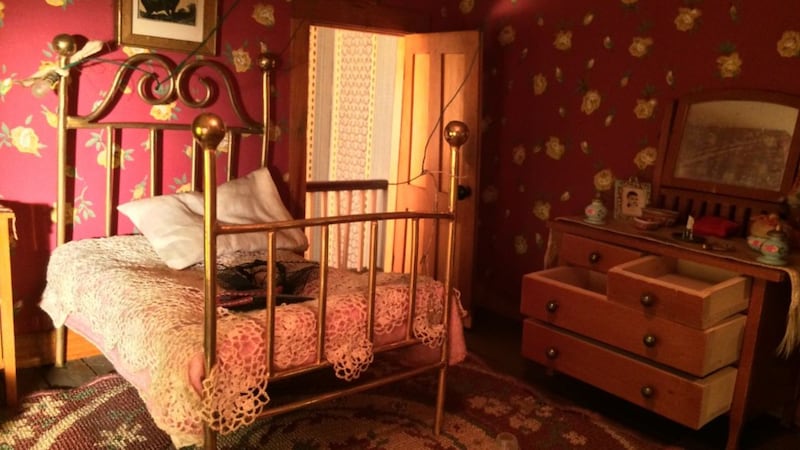The collection of doll houses that live in the Maryland Medical Examiner’s Office seem like any other at first glance, but between the walls of each lies a grisly crime scene shrouded in mystery.
Dainty drapes frame the windows of a kitchen in which a housewife has been hard at work. A steaming hot pie sits in the open oven opposite a delicately-laid dinner table that awaits a family of two. The ironing board is propped up in the centre of the room, while a wicker laundry basket lies beside it.
The intricate doll house paints a practically perfect picture of 1940s domesticity, all except for a final disconcerting decoration: a dead body.
The Nutshell Studies of Unexplained Death are a collection of 18 miniature crime scenes which depict a series of violent or mysterious deaths – be it cold-blooded murder, unfortunate accident or tragic suicide.
The dioramas were created over 70 years ago to provide crime scene analysts the tools to master the art of forensic investigation – and they’re still used to this day.
Crime scene investigators are presented with the Nutshells during a twice-annual training seminar in which they’re to pick apart each scene to determine what had actually occurred.
The models were created by a unique woman who was dubbed the “mother of forensic science”, and changed the world of pathology as we know it: Frances Glessner Lee.
“What Frances Glessner Lee did was elevate homicide investigation. She made it a scientific discipline, a profession. She was an advocate of the medical examiner system, helped change state laws, trained thousands of doctors and homicide investigators,” said Bruce Goldfarb, executive assistant to the chief medical examiner in Maryland.
Frances spent months conceptualising and recreating each of the Nutshells, which were inspired by real life crimes, using photographs, sketches and statements collected from police and witnesses.
Only the most complex of cases were chosen in order to challenge participants’ powers of observation.
Each model was meticulously crafted by hand in painstaking detail: doors swung on their tiny hinges, miniature hand-rolled cigarettes lay strewn across a table, light bulbs shone through their little lampshades.
While Frances took care of all the textiles and figures – the miniature furnishings, the clothes and the characters – carpenter Ralph Mosher constructed each room from blueprints he’d drawn up, on a scale of one inch to one foot.
In one scene, a woman can be found lying on her closet floor, with her head resting on a cardboard box. A deep gash has been carved across her throat, her neck is stained red, and a bloody knife lies aside her lifeless body. A chest of drawers stand behind her – each drawer pulled open – while a suitcase sits at the victim’s feet. Discarded liquor bottles litter the corner of the bedroom, along with a blood-soaked rag.
The inspiration for the collection derives from an old police saying: “Convict the guilty, clear the innocent, and find the truth in a nutshell” – though the truth proves harder to find in these elaborate Nutshells.
Frances Glessner Lee was born in 1878 as the youngest child and only daughter of the wealthy John and Frances Glessner in Chicago. As a child, she was known to be an engaging and precocious girl: an avid pianist and violinist, young Frances also had a love for foreign languages, the opera and sewing.
Frances glided into adulthood like many millionaire heiresses of her time did. University was not the encouraged destination for the 18-year-old; instead she waved her family goodbye to embark on a 14-month tour of Europe.
Once back on her home soil, Frances married an up-and-coming lawyer, Blewett Lee, yet the marriage was an unhappy one and after eight years and three children together, the couple separated.
Frances’ interest in legal medicine began after meeting Havard student Dr George Burgess Magrath who, as a medical examiner, used his knowledge and skills to solve mysterious deaths. Frances, while intrigued by Dr George’s grisly tales, learned of his complaints and the challenges medical examiners faced in their field of work.
Despite undergoing extensive training in forensics, medical examiners lacked the authority to start investigations of their own accord. They were deemed subservient to coroners, many of whom were not required to gain a degree to venture into the profession. Police – untrained in the method of collecting and preserving a crime scene – walked through pools of blood, moved objects from one location to another and disturbed the crime scene, hopelessly comprising the evidence.
Determined to see more skilled pathologists in the forensic world, Frances donated $250,000 of her riches to Harvard University, ensuring the creation of the first programme of legal medicine, training doctors as medical examiners.
Frances’ admirable dedication to the field of forensics saw her appointment as State Police Captain in New Hampshire in 1943 and, at the time, she was the only active female who held that position in the entire United States.
In her newly-appointed role, Frances established week-long intensive seminars in which police could develop the skills needed to investigate a crime scene thoroughly.
It was, of course, impractical to teach the budding detectives from a genuine crime scene and so Frances settled on the next best option – the Nutshell Studies of Unexplained Death.
Respected professionals from the world of legal medicine were invited to share their knowledge after which attendees were given 90 minutes to analyse the clues peppered throughout each mini crime scene before presenting their findings.
Those who completed the seminars graduated as Harvard Associates in Police Science.
While the dioramas of death were extensively used throughout Frances’ lifetime, there is no expiration date on her intricate creations.
The Nutshells are still used extensively in homicide training seminars to this very day – over half a century since their creation – in the exact same way. For that reason, the solutions are never made public.
“We still do the homicide seminar, and the Nutshells are still used – not because they are special, but because they work. There is really no other way to practice observation but by having something to look at,” Bruce said.
“You couldn’t do it with still photography, or with film. Even with the computer simulation and virtual reality technology of today, I don’t think they could adequately capture the experience of observing an actual three-dimensional object.”
Bruce said the tiny crime scenes are pivotal to the training of those in forensics because, despite the time that has passed since their creation, the facts of violent death have changed very little. There remain only a handful of ways to die violently – be it through a shooting, stabbing, strangling or poisoning – and other than the superficial details within each scene, the facts presented in each scenario are very much as relevant today.
“What the Nutshells teach is that you don’t have to walk through a crime scene to glean details and information. You can learn all kinds of things just by looking, not only about the facts of the death but also about who these people are, their socio-economic status and way of life, state of mind at the time of death,” he said.
Bruce said the Nutshells are just a very small part of Frances’ legacy – “practically an asterisk” – but an extraordinary one at that.
He said: “Lee is the only woman who made a significant contribution to forensic science. Nearly all of forensic science – fingerprinting, ballistics, trace evidence, forensic toxicology – was developed by men. Heck, all of police work was nearly exclusively a man’s world at the time.
“Lee is indeed the mother of forensic science.”








